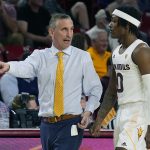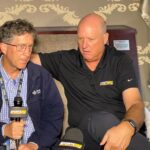A frenetic December jammed with coaching changes and transfer decisions shifts into a higher gear of mayhem Wednesday as the early signing period begins for high school recruits.
The three-day stretch will provide some clarity on major college rosters for the 2023 season and beyond but is just one of four windows for player movement in the sport’s dizzying offseason.
In chronological order, they are:
— Transfer portal I: Players are allowed to enter the portal over the course of six weeks, from the end of the regular season through the middle of January. (They do not have to select a destination school during that time, however
— Late signing window: High school recruits have the option to wait until the first Wednesday in February, the traditional period, to sign letters of intent. (This window remains open for two months.)
— Transfer portal II: The portal re-opens for two weeks in early May, giving players a chance to evaluate their options after spring practice.
Our preview of the Pac-12’s early signing window takes the ongoing transfer period into account. They are heavily intertwined in the roster-building process.
1. Collective failure … or success?
Oregon (No. 14) and Utah (No. 21) are the conference’s only other representatives in the top 25.
Meanwhile, the SEC has eight top-25 classes and the Big 12, which isn’t known as a recruiting powerhouse (beyond Texas and Oklahoma), has five.
In terms of specific prospects, the Pac-12 has secured commitments from just six of the top 20 recruits in California, and it’s set to lose a handful of blue-chip prospects from Washington.
But class quality no longer hinges entirely on high school recruits. When transfers are considered, the Pac-12’s outlook improves substantially.
Four programs currently possess top-10 transfer classes (USC, UCLA, Oregon and Utah), while three more (Arizona State, Colorado and Arizona) are in the top 25.
“The Pac-12 is seeing what can happen when you use the portal,” said Brandon Huffman, the national recruiting editor for 247 Sports who authors a weekly recruiting column for the Hotline.
“And what’s impressive is that schools aren’t only using it for top-end talent but also for building depth.”
As a result, the overall quality of incoming talent is far better, as compared to other Power Five leagues, than the traditional measure (high school signees) would suggest.
“This week alone, Washington and Oregon have benefitted from the portal,” Huffman said. “ASU has a slew of guys from the portal. Colorado has a handful, too. USC lived and died with it last year and is hitting it hard again.
“That’s a big story on the West Coast.”
2. The ‘Coach Prime’ effect
As was the case last year with another new, magnetic head coach (USC’s Lincoln Riley), all eyes are on Boulder as Deion Sanders attempts to overhaul his roster.
Sanders will lean into the transfer portal, but don’t ignore the potential for him to lure a few blue-chip prospects who would have never considered the Buffaloes previously.
Last year, Sanders executed a coup for the ages as cornerback Travis Hunter, the No. 1 recruit in the country, picked Jackson State. Could we see something comparable this month with an elite prospect in the class of 2023?
“It’s doubtful, but we could end up seeing Hunter himself at Colorado,” Huffman said. (Hunter is in the transfer portal but has not picked a destination.)
“I think Deion will get a few big-name players — maybe not top-five types — and then really ramp it up by February and expand the class like USC did last year.
“But considering how many players parted ways with Colorado upon his hiring, for the Buffs to have a class (with 13 committed recruits) before even touching the portal is significant. It shows the ‘Prime’ effect.”
3. UCLA’s rise
If Chip Kelly has a deep passion for recruiting, he hides it well. In previous recruiting cycles, the fifth-year UCLA head coach seemed to treat the process as a necessary evil that takes time away from studying film and drawing up plays.
But the Bruins are thriving on the recruiting trail this year and just grabbed the top-rated recruit of Kelly’s tenure: five-star quarterback Dante Moore, who had committed to Oregon but flipped his pledge.
“Is Kelly back? Is he recruiting?” Huffman said. “That’s not something we’ve seen a lot of — him going after top-100 players, let alone a top-five player.”
Add Moore to an incoming class that includes two four-star receivers, and the Bruins are rapidly restocking their skill-position talent.
4. Counting QBs
The impact of premier quarterbacks on the Pac-12 was evident in 2022 as transfers lifted USC, Washington and Oregon to meaningful seasons.
At the moment, four blue-chip talents are set to join the conference: five-star recruits Malachi Nelson (USC) and Moore (UCLA), plus four-star prospects Aiden Chiles (Oregon State) and Brayden Dorman (Arizona).
The transfer portal is delivering, as well, with Shedeur Sanders joining his father in Boulder, Drew Pyne heading to Arizona State (from Notre Dame) and Collin Schlee entering the UCLA fray (along with Moore).
We expect more new quarterbacks to pledge to the Pac-12, either during this three-day early signing window or through the transfer portal.
5. The NIL impact
The opportunity to profit from name, image and likeness endeavors is driving recruiting success, or causing recruiting failure, for many Power Five schools.
NIL takes two forms:
— The promotional and endorsement opportunities for players based on accomplishments for their team (i.e., NIL as intended).
— The corrupted version that’s used to lure recruits and transfers alike (NIL used as a proxy for pay-for-play).
“The elephant in the room is how much NIL factors into recruiting — and it does, substantially,” Huffman said. “Whether schools are doing the inducements and the pay-for-play, the reality is that it’s happening all over college football — and I don’t think the Pac-12 is ignoring it, either.
“But the Pac-12 is doing a better job showing there can be actual NIL coming once you’re on campus. Look no further than what (USC quarterback) Caleb Williams did last year with Beats By Dre and all the other deals he was able to sign at USC.
“There isn’t the inducement aspect; there isn’t the pay-for-play like you’re hearing about in the South.
“Instead, you’re hearing about the brand-building and marketing side it offers once players are already on campus.
“The Pac-12 has done a better job with what NIL was intended for and not what NIL is being used for in other parts of the country.”
*** The Hotline will publish a full breakdown of the Pac-12’s early signing period later this week.
*** Send suggestions, comments and tips (confidentiality guaranteed) to pac12hotline@bayareanewsgroup.com or call 408-920-5716
*** Follow Huffman on Twitter via @BrandonHuffman and support @AveryStrongDIPG
*** Follow me on Twitter: @WilnerHotline
*** Pac-12 Hotline is not endorsed or sponsored by the Pac-12 Conference, and the views expressed herein do not necessarily reflect the views of the Conference.
Related posts:

(AP Photo/Rick Scuteri)
Pac-12 MBB power ratings: UCLA, Arizona lead the gang that couldn’t shoot straight
Arizona State guard Frankie Collins, Jan. 14, 2023. (AP Photo/Amanda Loman)
Pac-12 rewind: UCLA sweeps, Utah stumbles, ASU keeps pace and Oregon’s wild ride rolls on
(AP Photo/Rick Scuteri)
Pac-12 MBB power ratings: ASU is the new No. 2, but its schedule could be problematic come March Hotline mailbag: Pros and cons of the Pac-12 partnering with Apple, expansion odds, merger options, backup plans and more
Hotline mailbag: Pros and cons of the Pac-12 partnering with Apple, expansion odds, merger options, backup plans and more

